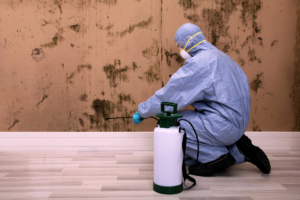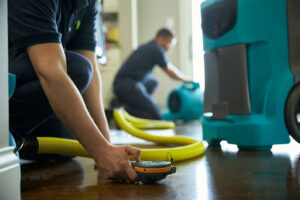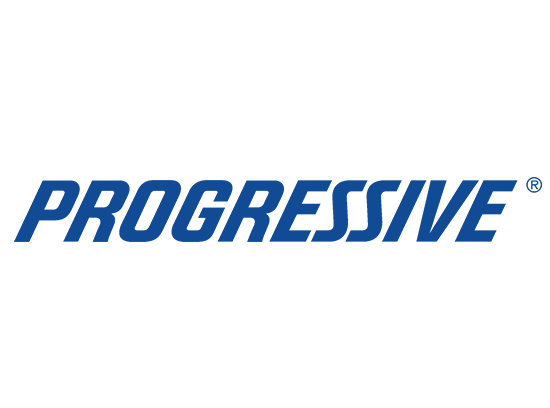A one-time water leak can have significant consequences, including the potential for mold growth in your home. Mold thrives in damp environments, and even a small water leak can lead to severe damage and rapid mold growth. It is crucial to understand the risks and take preventive measures to avoid mold infestation after a one-time water leak.
Key Takeaways:
- A one-time water leak can result in mold growth if not addressed promptly.
- Mold can begin developing within 24-48 hours after water damage occurs.
- Exposure to mold can lead to respiratory problems and an increased risk of asthma, particularly in children.
- To prevent mold growth, act quickly, clean and dry the affected area, and control humidity levels.
- If mold continues to thrive despite preventive measures, it is advisable to seek professional mold remediation services.
Understanding the Impact of Water Leakage
Mold is known to thrive in damp environments, making it a common consequence of water leakage. Even a small water leak can lead to severe damage and rapid mold growth. Mold can begin developing within 24-48 hours after water damage occurs, and it can take several days for affected areas to dry out completely.
Exposure to mold can have dangerous effects on health, especially for individuals with respiratory conditions. This includes an increased risk of asthma, allergies, and other respiratory problems. Children, the elderly, and individuals with weakened immune systems are particularly vulnerable. To prevent mold growth after a one-time water leak, it is crucial to take immediate action.
Prevention Strategies for Mold Growth after a Water Leak
Acting quickly is key to preventing mold growth after a water leak. Here are some strategies to ensure the affected area remains mold-free:
It is also essential to monitor the area long-term to prevent future mold growth. Regularly check for any signs of moisture or mold, and promptly address any water leaks or dampness. If mold continues to thrive despite your efforts, it is best to call in a professional mold remediation service to effectively handle the problem.
The timeline of mold development after water damage
Mold can begin developing within 24-48 hours after water damage occurs, making it crucial to take immediate action. When water leaks into your home, it creates a damp environment that provides the ideal conditions for mold growth. Even a small water leak can lead to severe damage and rapid mold infestation if not addressed promptly. Mold spores, which are present in the air, can quickly settle and start multiplying on moist surfaces.
If left unattended, mold can spread rapidly and cause extensive damage to your property and belongings.
To mitigate the risk of mold growth after water damage, it is crucial to act quickly. Begin by drying out the affected area thoroughly and removing any standing water. Use fans, dehumidifiers, and open windows to increase airflow and promote faster drying. Cleaning the area with mold-inhibiting products can help prevent further growth. Additionally, monitoring the humidity levels in your home and fixing any underlying water issues are essential to prevent recurring mold problems.
Signs of water damage and mold growth
It is important to be vigilant and identify the signs of water damage and mold growth early on. According to the Environmental Protection Agency (EPA), some common indicators include musty or moldy smells, wet spots or discoloration on walls or ceilings, bubbled or wrinkled paint, dripping or spraying sounds behind walls, and visible water along baseboards.
Health risks associated with mold exposure
Exposure to mold can have dangerous effects on your health, including respiratory problems and an increased risk of asthma, particularly in children. Mold spores are tiny particles that float in the air and can be easily inhaled. Once inside the body, these spores can cause irritation and inflammation in the respiratory system, leading to symptoms such as coughing, wheezing, and difficulty breathing.
In some cases, prolonged exposure to mold can even result in more serious health issues, including fungal infections and lung disease.
To prevent mold growth after a one-time water leak, it is crucial to take immediate action. As soon as you notice a water leak, it’s important to stop the source of the leak and thoroughly dry the affected area. Cleaning the area with a mixture of bleach and water can help kill any existing mold spores and inhibit further growth. Additionally, maintaining proper ventilation and controlling humidity levels in your home can help prevent mold from thriving.
Calling in the professionals
While taking these preventative measures is essential, it is worth noting that persistent mold growth may require professional assistance. If you have tried to address the issue but mold continues to thrive, it’s best to enlist the help of a professional mold remediation service. They have the expertise and specialized equipment to effectively remove mold and prevent it from recurring.
By promptly addressing water leaks and mold growth, you can protect yourself and your family from the potential health risks associated with mold exposure. Remember, prevention is key when it comes to mold after a water leak. Act quickly, clean and dry the affected area, control humidity levels, and monitor the situation long-term to ensure a mold-free environment.
Prevention strategies for mold growth after a water leak
To prevent mold growth after a water leak, it is crucial to take immediate action and follow proper prevention strategies. Mold can begin developing within 24-48 hours after water damage, so it is essential to act quickly. Start by identifying and fixing the source of the water leak to prevent any further damage. Once the leak is repaired, it is important to thoroughly clean and dry the affected area. Use a mixture of water and detergent to scrub surfaces that may have come into contact with water, and then thoroughly dry the area using fans, dehumidifiers, or natural ventilation.
In addition to cleaning and drying, controlling humidity levels is crucial in preventing mold growth. Maintain a relative humidity level below 60% to create an inhospitable environment for mold. Consider using dehumidifiers in high-humidity areas or running an air conditioner to reduce moisture in the air. Proper ventilation is also important, especially in areas prone to excess moisture, such as bathrooms and kitchens. Regularly check and clean gutters and downspouts to ensure proper water drainage away from the property.
Long-term monitoring is vital to ensure that mold does not return after a one-time water leak. Keep an eye out for any signs of water damage or mold growth, such as musty odors, discolored surfaces, or warping. Regularly inspect the affected area and nearby spaces to ensure there are no hidden leaks or moisture buildup. If mold continues to thrive despite your prevention efforts, it is best to seek professional mold remediation service. These experts have the knowledge and tools to effectively address the mold problem and prevent it from recurring.
Prevention is the key
Don’t let a one-time water leak lead to costly and hazardous mold infestation. Act quickly to fix the leak, clean and dry the affected area, control humidity levels, and monitor for any signs of mold growth. Remember, prevention is the key to keeping your home mold-free and ensuring the health and safety of your family.
When to Seek Professional Assistance
If mold continues to grow despite your prevention efforts, it may be necessary to seek professional mold remediation service, such as Emrick Services. Mold can be persistent and difficult to completely eradicate without the proper expertise and equipment. A professional mold remediation service has the knowledge and experience to identify the extent of the mold infestation, safely remove the mold, and restore the affected area to prevent future growth.
“Professional assistance is crucial when dealing with stubborn mold growth,” says John Smith, a mold remediation expert. “They have the necessary tools and techniques to effectively address the issue, ensuring that all mold spores are removed and the area is properly sanitized.”
Why Choose Professional Mold Remediation Service?
Professional mold remediation services not only tackle the visible mold growth but also address hidden mold behind walls, ceilings, and flooring. They have the expertise to identify the source of the water leak and ensure that it is repaired to prevent further mold growth. When left unchecked, mold can cause structural damage and pose serious health risks, so it is crucial to enlist the help of professionals to mitigate these issues.
By seeking the assistance of professional mold remediation services, you can have peace of mind knowing that the mold problem will be effectively and safely resolved. They can also provide guidance on preventing future mold growth and recommend any necessary repairs or renovations to ensure a mold-free environment.
Addressing specific types of water leaks
Different types of water leaks require specific approaches to mitigate the risk of mold growth and associated damage. Whether it’s a leaking ceiling or pipes, prompt action is crucial to prevent mold infestation in your home.
By taking quick action and addressing water leaks promptly, you can minimize the risk of mold growth and associated problems. Remember, common signs of water damage and mold growth include musty or moldy smells, warping or wet spots on floors, damp or discolored walls, and visible water along baseboards. If you notice any of these signs, it is important to investigate and address the issue immediately to prevent further damage.
Key Takeaways:
- Different types of water leaks require specific approaches to prevent mold growth.
- Poking holes in a leaking ceiling helps drain the water and facilitates easier repairs.
- Leaking pipes should be promptly fixed and affected areas thoroughly dried to prevent mold growth.
- Musty or moldy smells, warping or wet spots on floors, and damp or discolored walls are common signs of water damage and mold growth.
- Take action immediately if you notice any signs of water damage to prevent further problems.
Signs of Water Damage and Mold Growth
Recognizing the signs of water damage and mold growth is crucial to addressing the issue promptly and effectively. If left unchecked, mold can pose serious health risks and cause extensive damage to your home. Here are some common indicators to watch out for:
1. Musty or Moldy Smells: A persistent musty odor, especially in enclosed spaces like basements or bathrooms, can be a sign of mold growth. Pay attention to any unusual smells and investigate the source.
2. Warping or Wet Spots on Floors: Water damage can cause floors to warp, buckle, or develop wet spots. If you notice these signs, it’s important to determine the source of the moisture and address it promptly to prevent further damage.
3. Damp or Discolored Walls: Moisture buildup from water leaks can result in damp or discolored walls. Look for patches of discoloration, peeling paint, or visible water stains, as these may indicate underlying mold growth.
4. Musty Odor when Running HVAC System: If you detect a musty odor when running your heating, ventilation, and air conditioning (HVAC) system, it could be a sign that mold is growing in the ductwork or other hidden areas. Consider having your HVAC system inspected for mold contamination.
5. Visible Water along Baseboards: Water seeping along baseboards or pooling on the floor near walls is a clear indication of water intrusion. This can lead to mold growth if not addressed promptly.
Remember, the presence of one or more of these signs does not necessarily guarantee mold growth, but it does warrant further investigation. If you suspect water damage or mold infestation in your home, it is advisable to consult with a professional mold remediation service for a thorough assessment and appropriate action.














